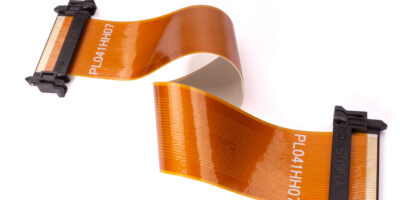Flexible data transmission can achieve 56Gbits per second over 100mm
Conventional technologies such as flexible flat cables and flexible printed circuits (FFC / FPC) or micro-coaxial cables cannot cope with continuously increasing data transmission rates between internal PCBs, explains Yamaichi Electronics, at the launch of its Y-Flex technology.
The Y-Flex cable uses liquid crystal polymer (LCP) as base material with layers of silver bumps and Yamaichi uses a 100 per cent reproducible production process. In order to achieve particularly high transmission speeds, it is important to match the Y-Flex specifically to the appropriate FFC / FPC connector, advised the company.
In principle, the Y-Flex mating face can be adapted to any standard ZIF, non-ZIF or LIF connector. However, Yamaichi says that specially developed high-speed ZIF or non-ZIF connectors, such as its HF507 series, are the most suitable for achieving optimal performance.
The biggest difference between Y-Flex and standard FPCs lies in the insulation material. Compared with the standard polyimides used in conventional FPCs, the LCP insulation material in the Y-Flex exhibits a much lower dielectric constant and a much lower dissipation factor at high frequencies to result in lower attenuation and higher data transmission rates than in standard FPCs. Moreover, says Yamaichi, LCP has superior hygroscopic properties compared with those of standard polyimide. This makes processing easier and allows trace spaces and widths of less than 30 micron to be realised. Its use in high relative humidity conditions is also much more stable, reports Yamaichi.
Transfer standards such as PCIe Gen 4 (16Gtransfers per second), USB 3.2 Gen 2 (10Gbits per second) or eDP HBR 3 (8.1Gbits per second) can be reached and data rates of 56Gbits per second (PAM4) were realised over a cable length of 100mm.
The reproducible production method means that all conductive traces are identical and thus achieve unprecedented constant transmission characteristics over their entire lengths. In contrast, in a coaxial cable, the relationship between inner and outer conductors differs along the cable due to the braid structure. There may also be length differences, which result in signal runtime variations.
The Y-Flex can be used in 5G testers and body scanners, autonomous vehicles, data networking, image processing and medical technology.




